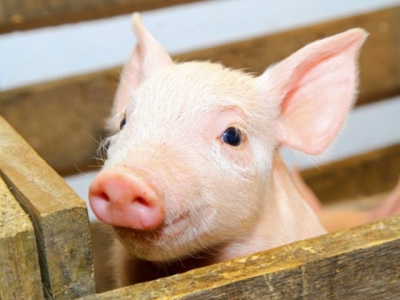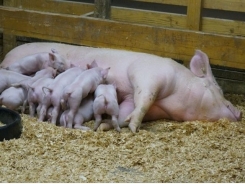DDGS may support nursery pig growth, performance when added to feed

Nursery pigs may maintain growth and performance when higher levels of dried distillers grains with solubles are added to their feed if diets are balanced or enzymes are used, says researcher.
A team of researchers from the University of Georgia explored the use of the enzymes xylanase (XYL) or b-glucanase (BGL) in nursery pig diets that included corn-based dried distillers grains with solubles (DDGS) at 30%, the group members said.
The work was published in the journal of Livestock Science.
The intent behind the initial study was to challenge a common idea that DDGS were not suitable for use in the diets of nursery pigs or not at high levels, said Michael Azain, corresponding author and professor in the department of animal and dairy science at the University of Georgia.
“The dogma in the swine literature was never use distillers grains in nursery pigs, and never at more than 5 – 10%,” he told FeedNavigator. “We wanted to look at what would happen.”
The research group also expanded upon the initial project to explore the use of different levels of the feed ingredient in young swine diets when the feeds were formulated using either a digestible amino acid basis or a total amino acid basis, said Azain. The additional pieces of the project were presented at a Midwest American Society of Animal Science (ASAS) meeting.
The initial project looking at use of carbohydrase enzymes found that adding the enzymes improved digestibility of dry matter, energy, neutral detergent fiber (NDF), acid detergent fiber (ADF), hemicellulose, phosphorus and crude protein (CP) along with the average daily gain (ADG), the researchers said. The added enzymes were able to partly reduce the negative effect of adding the DDGS to the diet.
However, the overall take away from the line of inquiry was that DDGS offer an acceptable, and likely lower cost, feed ingredient, said Azain.
“They can use it comfortably at 30% and it will result in lower diet cost even in the Midwest,” he said. “Even in the Midwest distillers grains are usually cheaper than corn and soybean meal and you’d be replacing some of both corn and soy.”
Exploring alternative ingredients and enzymes in feed
Another reason for exploring the use of DDGS in nursery pig feed is that the feed ingredient tends to be less expensive for producers to use, said Azain.
“In the Southeast, the feed prices are always higher than in the Midwest, because the corn and soy are grown in the Midwest,” he said. “We’re also always looking at things that could lower the cost of diets.”
Enzymes have been used as feed additives to degrade fiber, boost growth performance, feed efficiency and nutrient digestion for monogastric animals, said the researchers in the study. Use also has been found to limit the excretion of undigested nutrients.
Adding enzymes to diets has been shown to offer more benefit to young pigs than older ones, they said. XYL is an enzyme often used with a diet or feed ingredient contains levels of arabinoxylan, while BGL often is used when b-glucans are present – but it also has been used with diets including wheat, corn and soybean meal.
When starch is removed from corn in the production of ethanol, other elements, like fiber, are concentrated, they said. The fiber in DDGS is 3 to 4 times higher than what would be found in corn and soybean meal.
Study details and expansion
In the enzyme study, 135 pigs were given one of five diets for a period of 35 days starting after weaning at 21 days, the researchers said. The diets used included a common diet for the first seven days.
Experimental diets consisted of a positive control which included corn and soybean meal and no DDGS and a negative control which included 30% DDGS replacing a portion of the corn and soybean meal but with no added enzymes, they said. Additionally, the negative control diet was given with 4,000 unit/kg XYL, with b-glucanase at 450 unit/kg and the negative control diet with both enzymes (XB).
Enzyme-enriched diets and the negative control diet also were formulated to have a low level of metabolizable energy (ME) to highlight fiber degrading enzymes’ influence on energy use, they said.
Enzymes were provided by Danisco Animal Nutrition-DuPont Industrial Biosciences, which also partially funded the research project, they said.
Piglet body weight and feed intake were noted weekly, diet samples were kept for analysis and fecal samples were collected for three days at the end of phase 2(days 7-21) and phase 3 (days 21-35), said the researchers.
Additionally, in the related trials looking at different levels of DDGS in the diet, pigs were given feeds that included increasing levels of DDGS – 0%, 10%, 20% and 30% and that were formulated on a total lysine basis, said the research group. A second test used diets that included 0%, 10%, 20% 30% 37.5% and 45% DDGS and that were formulated on a digestible lysine basis.
Results
In the feeding trial examining enzyme use, the negative control diet and the diets with added enzymes had higher levels of ADF and NDF, said the researchers.
Overall, pigs getting diets with one of the enzymes had better body weight than those getting the negative control, they said. Pigs getting the diet with the enzyme combination had a similar bodyweight to those getting the positive control.
Pigs getting the negative control diet had the lowest ADG and single enzyme supplementation results were similar, they said. ADG for pigs getting the combined enzymes were similar to pigs on the positive control diet.
Average daily feed intake was higher for all of the diets including DDGS regardless of enzyme additive, they said. Apparent total tract digestibility for dry matter, energy and CP was highest for pigs on the positive control, while the XYL and XB diets outperformed the negative control.
Digestibility of energy improved in diets with added enzymes compared to the negative control and CP digestibility was improved when enzymes were added, they said. Enzyme use boosted digestion of NDF, ADF and hemicellulose above both positive and negative controls.
“I didn’t expect that we could go that high with DDGS,” said Azain of unexpected results from the studies.
“We [also] had the one study where we had distillers that was high in mycotoxins,” he said. “That’s always a concern, even with corn it’s possible to have mycotoxins, so you have to be aware of that.”
In the experiment looking at diets generated on a total lysine basis, average daily gain decreased as the amount of DDGS in the diet rose, the researchers said.
However, when examining the use of varying levels of DDGS in diets that were formulated on the basis of digestible lysine, adding up to 45% DDGS did not alter average daily gain or average daily feed intake, the researchers said. Apparent digestibility of energy and protein did fall as more DDGS were added, but phosphorus digestibility improved.
Có thể bạn quan tâm
Phần mềm

Phối trộn thức ăn chăn nuôi

Pha dung dịch thủy canh

Định mức cho tôm ăn

Phối trộn phân bón NPK

Xác định tỷ lệ tôm sống

Chuyển đổi đơn vị phân bón

Xác định công suất sục khí

Chuyển đổi đơn vị tôm

Tính diện tích nhà kính

Tính thể tích ao hồ



 Weanling pigs may see digestion bump from additive…
Weanling pigs may see digestion bump from additive…  Amino acid may give piglets a boost
Amino acid may give piglets a boost